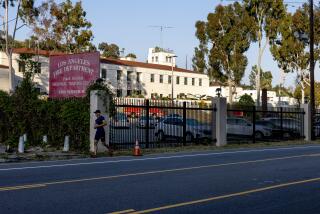Study Hails Weather Tower
- Share via
Ojai residents’ efforts to remove a weather radar tower on Sulphur Mountain over health concerns was dealt another blow this week after an advisory group reported that the facility is properly located and is effective in forecasting flash floods.
Since the tower’s installation 11 years ago, neighbors have complained about the potential health effects of being exposed to the 750,000 watts of microwave energy emitted by the National Weather Service’s giant golf ball-like equipment. They also consider it an eyesore that has driven down their property values.
So when U.S. Sen. Barbara Boxer (D-Calif.) requested last year that the Research Council of the National Academy of Sciences study the tower’s effectiveness, community activists were hopeful that it would be an opportunity to move the tower. But the study focused entirely on the tower’s operations, rather than any health risks it might pose to residents of the sparsely populated mountain.
“The report makes it pretty clear the Sulphur Mountain radar ... provides great value to the citizens of Southern California in protecting them from flash floods,” said Greg Romano, a National Weather Service spokesman.
The National Weather Service has said that electromagnetic emissions 1,000 feet from the tower are substantially less than standing 10 feet from a microwave oven or using a cellphone.
But Bruce Garber, who lives on Sulphur Mountain Road less than a mile from the tower, isn’t convinced there is enough evidence about the long-term effects of living so close to a radar tower.
“We don’t want our children exposed to that radiation day after day, because nobody knows how chronic exposure can affect someone’s health,” said Garber, one of several dozen residents who have sought Boxer’s help in getting the tower relocated.
“I’m no scientist; I’m an English teacher,” he said. “My question is: Why would you put a radar tower in the middle of a residential neighborhood? The fear of people being exposed to it day after day is not rational.”
Boxer, campaigning Thursday in Modoc County, declined to comment on the report.
The Doppler radar -- which bounces signals off clouds to gauge moisture content and estimate when and how hard it will rain -- has improved the National Weather Service’s local office’s accuracy and timeliness in forecasting and monitoring storms that result in flash floods, according to the report. Ventura County averages six flash floods a year.
From 1996 through 2003, the tower helped the National Weather Service’s Los Angeles-Oxnard office accurately predict 83% of the region’s flash floods, better than a 75.5% average success rate for the nation’s 116 forecast stations with similar equipment, according to the report.
Warning times with the radar increased from about seven minutes to 35 minutes, which is double the goal for stations in Western states but less than the average national lead time of 47 minutes, the report said.
“The radar is doing what it’s supposed to do,” said Gregory S. Forbes, the Weather Channel’s severe weather expert and a member of a 10-person committee that created the 108-page report released Wednesday. “The Sulphur Mountain radar is the only one covering a part of the ocean where certain storms are coming in over that area of Southern California. It’s serving a critical role.”
False alarms, predicted floods that didn’t materialize, decreased from about half of all warnings issued to 39% during the period between 1995 and the end of 2003. The radar failed to warn of 11 of the 57 flash floods that occurred during this period.
Though component failures dropped Sulphur Mountain’s service availability below federal standards several times from 1995 to 1998, the radar tower has averaged 98.9% reliability since then, the report found.
Scott Holder, interim senior hydrologist for the Ventura County Watershed Protection District, said the radar tower is just one tool his agency uses to measure rainfall and monitor levels of local streams and rivers during winter storms.
“If this report says this is the best spot for [the radar], it’s probably the best spot,” Holder said. “There’s no one spot you can put a radar to cover the entire county.”
The equipment on Sulphur Mountain is 2,726 feet above sea level and can measure precipitation in clouds, including those lower than 6,000 feet, up to 78 miles away. Holder said the radar misses areas in the northern part of the county blocked by mountains.
To enhance flash-flood predictions in hilly and mountainous locations, the report suggests weather personnel receive real-time data from all Doppler towers in a region, including those owned by the Federal Aviation Administration and at Vandenberg Air Force Base near Lompoc.
The National Oceanic and Atmospheric Administration, the agency that oversees the National Weather Service, also will review the research council’s findings.
More to Read
Sign up for Essential California
The most important California stories and recommendations in your inbox every morning.
You may occasionally receive promotional content from the Los Angeles Times.











